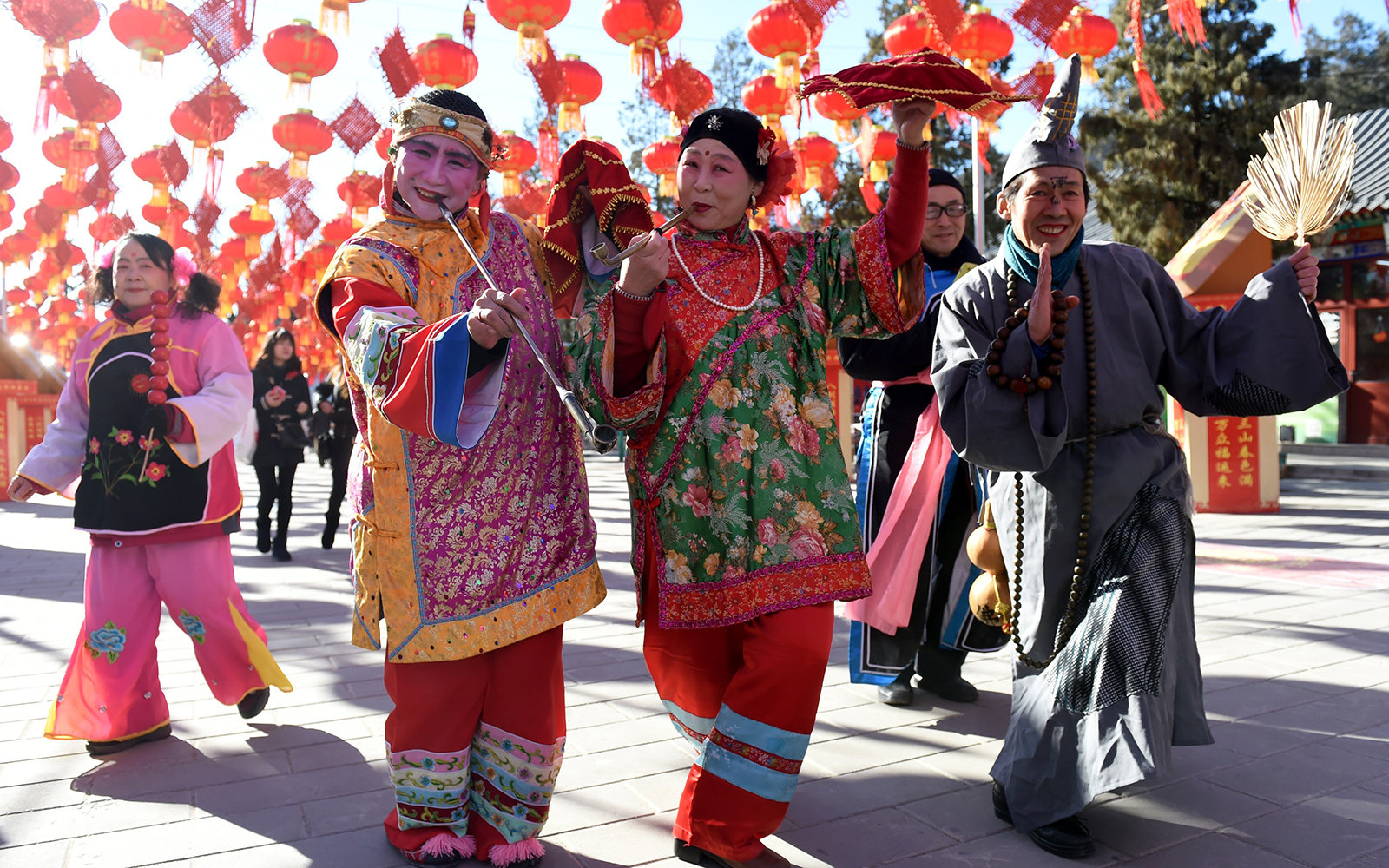
The best way to celebrate the arrival of the Year of the Monkey? In Beijing, it's all about the temple fair.
For residents of Beijing, attending a local miaohui, or temple fair, comes second only to the big family dinner when celebrating the Chinese New Year. Typically held at temples and parks, these week-long events combine religion, shopping, culture, entertainment, and food, and are open to all. This year, the spring festival takes place February 7 through 13, and ushers in the Year of the Monkey.
Temple fairs trace their roots as early as the Wei dynasty, but today they're lively gatherings, packed with things to do. Expect vendors hawking regional snacks, accessories, toys, souvenirs, and folk art, while lion dances, comedy, kung fu demonstrations, and puppet shows take place. You'll see traditional crafts like decorative paper that symbolize good luck, clay figurines, blown sugar art, and Chinese calligraphy scrolls, and have the chance to sample hyper-authentic eats. Here are five temple fairs not to miss in Beijing.
Built in 1530 by the Jiajing Emperor, Ditan Park houses the Temple of the Earth, where Ming and Qing rulers offered ritual sacrifices to the God of the Earth every summer solstice. A reenactment of this ceremony is considered the highlight of the annual fair. Every year, a sea of colorful fans and red lanterns are hung all over the park for the occasion, with folk performances, art exhibitions, and food stalls selling specialties from Beijing, Sichuan, Tianjin, Xinjiang, and beyond. (Admission: $1.50, February 8 through 14, Ditan Park, A2 Andingmen Outer St., Dongcheng District.)
As the headquarters of the Taoist Association of China, White Cloud Temple hosts one of the few Spring Festivals that retains its religious roots. Every year, the devout visit the temple to burn incense and pray for health and prosperity. The complex is divided into three sections laid out in a straight line, with a garden at the back and statues of Taoist figures dotting the various halls.
In the northern part of the temple, there's a large brass coin with a square hole hanging from an arched bridge. It is said that fortune will come to those who can hit the small bell suspended in the middle of the hole with a regular-sized coin. Because 2016 is also the Year of the Monkey, expect to see groups of visitors looking for the three stone monkeys hidden throughout the temple. It's said that those who manage to find and touch all three will have their wishes come true. (Admission: $1.50, February 8 through 26, 6 White Cloud Temple Street, Xicheng District.)
Once known as "the Versailles of the East," Yuanmingyuan (the Old Summer Palace) was the site of Spring Festival celebrations for the Qing imperial family. The administrative office's decision to establish a temple fair there in 2010 was a controversial one, as the looting and burning of the palace by British and French forces in 1860 still looms large in Chinese collective memory.
Yuanmingyuan hosts the city's only imperial-themed miaohui; expect ice skating performances, cultural exhibitions, historical costume displays, and a "royal market" with imperial-style snacks, calligraphy, paintings, crafts, as well as dengmi, a traditional activity where visitors guess the answer to a riddle written on a lantern or slip of paper. (Admission: $1.50, February 8 through 14, Yuanmingyuan, 28 Qinghua Rd., Haidian District.)
Founded in 1319, Dongyue is a Taoist temple dedicated to the god of Mount Tai, one of China's five sacred Taoist mountains. Despite its modest size, the temple hosts one of Beijing's longest-running celebrations. Locals traditionally visit to ask for blessings, noted in the decorations and souvenirs bearing fu, the Chinese character for "fortune" or "good luck," that adorn the temple. The practice of depicting fu upside down on a piece of red square paper stems from a Chinese pun; the words "upside down" and "to arrive" are both pronounced dào in Mandarin Hence, hanging fu upside down on a door signals that good fortune has arrived. (Admission: $1.50, February 8 through 14, 141 Chaoyangmen Outer St., Chaoyang District.)
The Changdian temple fair historically took place near Liulichang in Beijing's former Xuanwu District, which was absorbed into the Xicheng District in 2010. "Changdian" refers neither to a street nor a specific landmark, but an area that formerly contained three temples.
In 2011, the fair was moved to Taoranting Park in southern Beijing, a former gathering place for poets and writers founded by the Kangxi Emperor in 1695. The park get its name from a Tang dynasty poem by Bei Juyi that describes the author's feelings of taoran ("happy and carefree") among the yellow chrysanthemums. The Changdian temple fair hosts xiangsheng performances, Beijing opera, dragon dances, acrobatic shows, food vendors, and traditional handicraft vendors. (Admission: $1.50, February 8 through 14, Taoranting Park, 19 Taiping St., Xicheng District.)
Sijia Chen is based in Beijing and covers the city for Travel + Leisure.